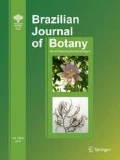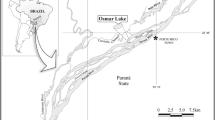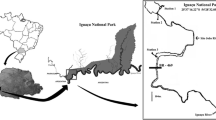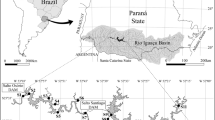Abstract
The study of phytoplankton morphological characteristics, using the morphology-based functional classification (MBFG), reflects the different abilities for absorption of light and nutrients, growth, mechanisms for preventing sedimentation and predation in the aquatic ecosystem and can be a model in simplification of the phytoplankton community dynamics in the reservoirs. This study that was developed in a tropical reservoir aimed to evaluate which phytoplankton morphofunctional characteristics are selected by the spatial and temporal heterogeneity in the reservoir, and how these characteristics are related to the environmental conditions. For this, phytoplankton and environmental variables were sampled in different sites along the spatial extent of the reservoir during dry and rainy periods. The lotic region showed the greatest environmental dissimilarity in relation to the other regions, both in the dry and rainy periods. Differences in density of all MBFG were verified along the spatial extent of the reservoir, with higher values in the lentic region, while differences between hydrological periods were verified for MBFG I (small organisms with a high surface/volume ratio), MBFG IV (medium-sized organisms without specialized traits) and MBFG VII (large mucilaginous colonies). The conditions of pH, temperature and turbidity were important in the selection of the morphofunctional characteristics and in MBFG dynamics. Therefore, the use of MBFG can be a form of simplification of the relationship between phytoplankton and environmental heterogeneity, reflecting the reservoir functioning.






Similar content being viewed by others
References
Apha (2017) Standard methods for the examination of water and wastewater. American Public Health Association, American Water Works Association, and Water Environment Federation, Washington, DC
Azevedo ADS, Moura AN, Aragão-Tavares NKC, Dantas EW (2020) Taxonomic and functional approaches to phytoplankton in ecosystems with different coverage of aquatic plants. Braz J Bot 43:665–675
Beamud SG, Léon JG, Kruk C, Pedrozo F, Diaz M (2015) Using trait-based approaches to study phytoplankton seasonal succession in a subtropical reservoir in arid central western Argentina. Environ Monit Assess 187:271
Bianchini-Junior I, Cunha-Santino MB (2018) Reservoir management: an opinion to how the scientific community can contribute. Acta Limnol Bras 30:e301
Bicudo CEM, Menezes M (2017) Gêneros de Algas de Águas continentais do Brasil: chave para identificação e descrições. RiMa, São Carlos
Boccard D, Gillet F, Legendre P (2011) Numerical ecology with R. Springer, New York
Bortolini JC, Moresco GA, Paula ACM, Jati S, Rodrigues L (2016) Functional approach based on morphology as a model of phytoplankton variability in a subtropical floodplain lake: a long-term study. Hydrobiology 767:151–163
Bortolini JC, Silva PRL, Baumgartner G, Bueno NC (2019) Response to environmental, spatial, and temporal mechanisms of the phytoplankton metacommunity: comparing ecological approaches in subtropical reservoirs. Hydrobiologia 830:45–61
Brazil J, Huszar VLM (2011) The role of functional traits in the ecology of continental phytoplankton. Oecol Aust 15:799–834
Câmara FRA, Rocha O, Pessoa EKR, Chellapa S, Chellapa NT (2015) Morphofunctional changes of phytoplankton community during pluvial anomaly in a tropical reservoir. Braz J Biol 75:628–637
Cardoso MRD, Marcuzzo FFN, Barros JR (2014) Classificação climática de Köppen Geiger para o estado de Goiás e o Distrito Federal. Acta Geográfica 8:40–55
Carmo EJS (2014) Planktonic cyanobacteria from the Ribeirão João Leite reservoir (Goiás) during the filling phase: floristic and flowering. Masters dissertation. Department of Botany, Federal University of Goiás. p.119
Carneiro FM, Bini LM (2020) Revisiting the concept of longitudinal gradients in reservoirs. Acta Limnol Bras 32:e8
Carneiro FM, Bini LM, Rodrigues LC (2010) Influence of taxonomic and numerical resolution on the analysis of temporal changes in phytoplankton communities. Ecol Indic 10:249–255
Costa HC, Marcuzzo FFN, Ferreira OM, Andrade LR (2012) Spatialization and seasonality of rainfall precipitation in the state of Goiás and the federal district. Braz J Phys Geogr 01:87–100
Cupertino A, Gücker B, Von Rückert G, Figueredo CC (2019) Phytoplankton assemblage composition as an environmental indicator in routine lentic monitoring: Taxonomic versus functional groups. Ecol Indic 101:522–532
Dalgaard P (2020) ISwR: introductory statistics with R. R package version 2.0–8. https://CRAN.R-project.org/package=ISwR. Acessed May 2020
Deus R, Brito D, Kenov IA, Lima M, Costa V, Medeiros A, Neves R, Alves CN (2013) Three-dimensional model for analysis of spatial and temporal patterns of phytoplankton in Tucuruí reservoir, Pará, Brazil. Ecol Model 253:28–43
Geist J (2011) Integrative freshwater ecology and biodiversity conservation. Ecol Indic 11:1507–1516
Huszar VLM, Giani A (2007) Amostragem da comunidade fitoplanctônica em águas continentais: reconhecimento de padrões espaciais e temporais. In: Bicudo CEM, Bicudo D (eds) Amostragem em Limnologia. Rima, São Carlos, pp 133–147
Kennedy RH, Thornton KW, Ford DE (1985) Characterization of the reservoir ecosystem. In: Gunnison D (ed) Microbial processes in reservoirs. Developments in hydrobiology. Springer, Dordrecht
Kimmel BL, Lind OT, Paulson LJ (1990) Reservoir primary production. In: Thornton KW, Kimmel BL, Payne FE (eds) Reservoir limnology: ecological perspectives. Wiley, New York
Kruk C, Segura AM (2012) The habitat template of phytoplankton morphology-based functional groups. Hydrobiology 698:191–202
Kruk C, Huszar VLM, Peeters EHM, Bonilla S, Costa L, Lurling M, Reynolds CS, Scheffer M (2010) A morphological classification capturing functional variation in phytoplankton. Freshw Biol 55:614–627
Kruk C, Peeters ETHM, Van Nes EH, Huszar VLM, Costa LS, Scheffer M (2011) Phytoplankton community composition can be predicted best in terms of morphological groups. Limnol Oceanogr 56:110–118
Li Q, Xiao J, Ou T, Han M, Wang J, Chen J, Li Y, Salmaso N (2018) Impact of water level fluctuations on the development of phytoplankton in a large subtropical reservoir: implications for the management of cyanobacteria. Environ Sci Pollut Res 25:1306–1318
Litchman E, Klausmeier CA (2008) Trait-based community ecology of phytoplankton. Annu Rev Ecol Evol Syst 39:615–639
Litchman E, Pinto PT, Edwards KF, Klausmeier CA, Kremer CT, Thomas MK (2015) Global biogeochemical impacts of phytoplankton: a trait-based perspective. J Ecol 103:1384–1396
Lobo MTMP, Nogueira IS, Sgarbi LF, Kraus CN, Bomfim EO, Garnier J, Marques DM, Bonnet MP (2018) Morphology-based functional groups as the best tool to characterize shallow lake-dwelling phytoplankton on an Amazonian floodplain. Ecol Indic 95:579–588
Lund JWG, Kipling C, Lecren ED (1958) The inverted microscope method of estimating algal number and the statistical basis of estimating by couting. Hydrobiologia 11:980–985
Machado KB, Borges PP, Carneiro FM, Santana JF, Vieira LCG, Huszar VLM, Nabout JC (2015) Using lower taxonomic resolution and ecological approaches as a surrogate for plankton species. Hydrobiologia 743:255–267
Magalhães L, Rangel LM, Rocha AM, Cardoso SJ, Silva LHS (2020) Responses of morphology-based phytoplankton functional groups to spatial variation in two tropical reservoirs with long water-residence time. Inland Waters. https://doi.org/10.1080/20442041.2020.1745007
Nogueira MG, Henry R, Maricatto FE (1999) Spatial and temporal heterogeneity in the Jurumirim Reservoir, São Paulo, Brazil. Lakes Reserv Res Manag 4:107–120
Oksanen J, Blanchet FG, Friendly M, Kindt R, Legendre P, McGlinn D, Minchin PR, O'Hara RB, Simpson GL, Solymos P, Stevens MHH, Szoecs H, Wagner H (2019) Vegan: community ecology package. R package version 2.5–6. https://CRAN.R-project.org/package=vegan. Accessed in May 2020
Pianka ER (1970) On r and K selection. Am Nat 104:592–597
Pivato BM, Train S, Rodrigues LC (2006) Dinâmica nictemeral das assembléias fitoplanctônicas em um reservatório tropical (reservatório de Corumbá, Estado de Goiás, Brasil), em dois períodos do ciclo hidrológico. Acta Sci Biol Sci 28:19–29
R Development Core Team (2017) R: a language and environment for statistical computing. R Foundation for Statistical Computing, Vienna, Austria. http://www.R-project.org/. Accessed in May 2020
Rangel LM, Soares MCS, Paiva R, Silva LHS (2016) Morphology-based functional groups as effective indicators of phytoplankton dynamics in a tropical cyanobacteria-dominated transitional river: reservoir system. Ecol Indic 64:217–227
Reynolds CS (1988) Functional morphology and the adaptative strategies of freshwater phytoplankton. In: Sandgren CD (ed) Growth and reproductive strategies of freshwater phytoplankton. Cambridge University Press, Cambridge, pp 388–434
Reynolds CS (1994) The long, the short and the stalled: on the attributes of phytoplankton selected by physical mixing in lakes and rivers. Hydrobiologia 289:9–21
Reynolds CS (1997) Vegetation process in the pelagic: a model for ecosystem theory. In: Kinne O (ed) Excellence in ecology. Oldendorf, Ecology Institute
Reynolds CS, Huszar VLM, Kruk C, Naselli-Flores L, Melo S (2002) Towards a functional classification of the freshwater phytoplankton. J Plankton Res 24:417–428
Rodrigues LC, Pivato BM, Vieira LCG, Bovo-Scomparin VM, Bortolini JC, Pineda A, Train S (2018) Use of phytoplankton functional groups as a model of spatial and temporal patterns in reservoirs: a case study in a reservoir of central Brazil. Hydrobiologia 805:147–161
Rudman SM, Kreitzman M, Chan KMA, Schluter D (2017) Evosystem Services: Rapid Evolution and the Provision of Ecosystem Services. Trends Ecol Evol 32:403–415
Salmaso N, Naselli-Flores L, Padisák J (2015) Functional classifications and their application in phytoplankton ecology. Freshw Biol 60:603–619
Santana RMC, Dolbeth M, Barbosa JEL, Patrício J (2018) Narrowing the gap: Phytoplankton functional diversity in two disturbed tropical estuaries. Ecol Indic 86:81–93
Santos EHMD, Griebeler NP, Oliveira LFCD (2010) Relação entre uso do solo e comportamento hidrológico na Bacia Hidrográfica do Ribeirão João Leite. Rev bras eng agríc amb pp. 826–834
Segura AM, Sarthout F, Kruk C (2018) Morphology-based differences in the thermal response of freshwater phytoplankton. Biol Lett 14:20170790
Soares MCS, Marinho MM, Huszar VLM, Branco CWC, Azevedo SMF (2008) The effects of water retention time and watershed features on the limnology of two tropical reservoirs in Brazil. Lakes Reserv Res Manag 13:257–269
Stanford JA, Ward JV (2001) Revisiting the serial discontinuity concept. Regul Rivers: Res Manage 17:303–310
Straskraba M (1999) Retention time as a key variable of reservoir limnology. In: Tundisi TG, Straskraba M (eds) Theoretical reservoir ecology and its applications, international institute of ecology. Brazilian Academy and Backhuys Publishers, São Carlos
Thornton KW (1990) Sedimentary processes. In: Thornton KW, Kimmel BL, Payne FE (eds) Reservoir limnology: ecological perspectives. Wiley, New York
Tundisi JG (2018) Reservoirs: New challenges for ecosystem studies and environmental management. Water Security 4–5:1–7
Tundisi JG, Matsumura-Tundisi T (2003) Integration of research and management in optimizing multiple uses of reservoirs: the experience in South America and Brazilian case studies. Hydrobiologia 500:231–242
Utermöhl H (1958) Zur Vervollkommnung der quantitativen phytoplankton-methodic. Verh Internat Verein Theor Angew Limnol 9:175
Vieira MC, Bini LM, Velho LFM, Gomes LF, Nabout JC, Vieira LCG (2017) Biodiversity shortcuts in biomonitoring of novel ecosystems. Ecol Indic 82:505–512
Wojciechowski J, Heino J, Bini LM, Padial AA (2017) The strength of species sorting of phytoplankton communities is temporally variable in subtropical reservoirs. Hydrobiologia 800:31–43
Zhang W, Lou I, Huang J (2017) Water resources and importance of reservoirs. In: Lou I, Han B, Zhang W (eds) Advances in monitoring and modeling algal blooms in freshwater reservoirs. Springer, Dordrecht
Acknowledgments
RMLT is grateful to UFG (Federal University of Goiás) for a scientific initiation scholarship. The authors are grateful to Goiás Sanitation Company (Saneago) for logistic support and support for the development of research.
Author information
Authors and Affiliations
Contributions
RMLT and JCB contributed to conceptualization and design of study, formal analysis, visualization and writing—review and editing; CRAS was provided funding acquisition; RMLT, SMS, CAS, CRAS and JCB contributed to methodology; and RMLT was provided writing—original draft. All authors approved the final version of the manuscript.
Corresponding author
Ethics declarations
Conflict of interest
Authors declare that they have no conflict of interest.
Additional information
Publisher's Note
Springer Nature remains neutral with regard to jurisdictional claims in published maps and institutional affiliations.
Rights and permissions
About this article
Cite this article
Trindade, R.M.L., dos Santos, S.M., de Souza, C.A. et al. Using morphofunctional characteristics as a model of phytoplankton dynamics in a tropical reservoir. Braz. J. Bot 44, 467–477 (2021). https://doi.org/10.1007/s40415-021-00705-z
Received:
Revised:
Accepted:
Published:
Issue Date:
DOI: https://doi.org/10.1007/s40415-021-00705-z




